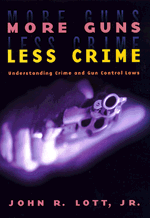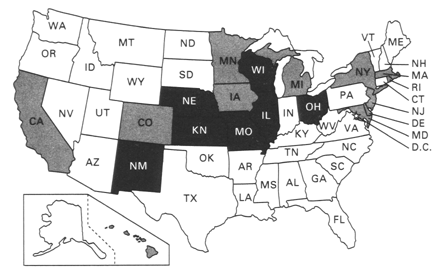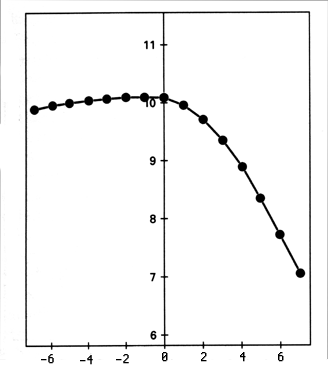 |
 |
A law abiding citizen with a concealed gun can ruin a criminal's day. The more concealed guns in a community, the more a criminal is apt to go elsewhere, or seek another line of work.
One cannot directly measure the criminal's perception of the numbers of guns in a community. It is also hard to measure the actual number of guns being carried. One can learn the number of conceal carry permits that have been issued in an area. That is what John Lott measured. He found that the more concealed gun permits issued, the fewer crimes committed. If this isn't quite "More Guns Less Crime," it is certainly cause to issue more conceal carry permits, and to encourage those with the permits to carry.
The first few tables present raw numbers from the FBI's crime statistics. They simply compare the crime rates in states with shall issue conceal carry policies against states with more restrictive gun control laws.
 |
|
White - Shall Issue Concealed Carry |
|
Type |
Concealed |
Others |
Higher |
Concealed |
Concealed |
|
|
Gray |
|
|
||
|
|
|
|
|
|
|
|
|
|
|
|
|
|
|
|
|
|
|
|
|
|
Assault |
|
|
|
|
|
|
|
|
|
|
|
|
|
Crime |
|
|
|
|
|
|
|
|
|
|
|
|
|
|
|
|
|
|
|
|
|
|
|
|
|
|
These raw numbers are fairly impressive. I would rate this raw number state by state argument as at least the equal of the arguments on the USA, World and On Killing pages. The author, John Lott, rates this approach as badly flawed. Might the conceal carry shall issue states have other things in common, factors that also reduce crime rates? As an example, the gun control states include the Boston - Washington corridor, many of the Midwest industrial states, and California. Many of the conceal carry states are rural. Might the difference in crime be related to wealth, population density, or some other factor? Are the gun control laws increasing crime, by rendering potential victims defenseless? Or does crime cause gun control, as the laws are only tried where the problems are worst.
To determine how much is due to conceal carry laws, and how much to other factors, one has to "control" the other factors. What is the effect of population density on crime rates? Income? Arrest rates? Only after isolating and accounting for the effect of other controlled variables can one say how much conceal carry laws were a factor. Lott used crime, population and economic statistics from all 3,000 + US counties over a span of 18 years to do just this. The below table includes a sampling of the more relevant and significant control variables, but is by no means a complete list.
|
|
|
|
Assault |
|
|
|
|
|
Conceal Carry Law Passed |
|
|
|
|
|
|
|
|
|
|
|
|
|
|
|
|
|
|
|
|
|
|
|
|
|
|
$1,000 |
|
|
|
|
|
|
|
|
$100 |
|
|
|
|
|
|
|
|
$100 |
|
|
|
|
|
|
|
|
$1,000 |
|
|
|
|
|
|
|
|
Increase 100,000 |
|
|
|
|
|
|
|
In short, More Guns Less Crime. A constant drop in crime rate by adapting a concealed carry law is simplistic. The drop actually varies in size depending on how many guns are carried. There is no free lunch. People actually have to protect the community for the community to be protected. The above number, however, is representative.
Either the raw numbers or the refined version is persuasive. No one is attacking the raw version. This is a fairly straightforward compilation of FBI records. The processed version is getting most of the attention. Unfortunately, if one is not a professional statistician, it is hard to know if the methods used by Lott are appropriate. The original study was published in a peer reviewed academic journal. The author answers scientific criticisms of the work reasonably well. I shall leave the technical criticisms to another site, and to chapter seven of the book. I am a computer person, but not a statistics expert. I came out moderately convinced. The critics that came closest to duplicating Lott's work seemed to be looking for excuses to throw away data. To make the result less significant statistically, they exclude 85% of the data. When attempting to control for as many variables as Lott is going after, you can't do that. You need as many data points as you can get to give the computer enough information to digest.
 |
|
X Axis -Murder Rate per 100,000 population Y Axis - Years before / after Conceal Carry Shall Issue Law |
The nontechnical criticisms are even more interesting. As I've said elsewhere, the gun control debate is a values issue. People follow their hearts more than the data. This can be traumatic when someone like Lott comes along, examining what had been a values issue with scientific methods. As the gun control people are absolutely sure they are correct, a values based certainty matching that of the NRA, they freely use what would otherwise be considered immoral or unethical methods. I shall quote a pair of fallacies, from Constructing a Logical Argument, a document on proper debating methods oft posted on Internet forums where flame wars have gotten out of hand.
Argumentum ad hominem is literally "argument directed at the man". The Abusive variety of Argumentum ad Hominem occurs when, instead of trying to disprove the truth of an assertion, the arguer attacks the person or people making the assertion. This is invalid because the truth of an assertion does not depend upon the goodness of those asserting it. For example: "Atheism is an evil philosophy. It is practiced by Communists and murderers."The straw man fallacy is to misrepresent someone else's position so that it can be attacked more easily, then to knock down that misrepresented position, then to conclude that the original position has been demolished. It is a fallacy because it fails to deal with the actual arguments that have been made.
As an example, one gun control advocate claimed Lott favored Archie Bunker's policy for preventing aircraft hijackings, which is issuing a gun to everyone boarding the aircraft. Lott did repeat this Archie quote in one of his studies, but he did so to note why Americans find the joke funny. Americans quite well understand the risks of arming the general public. He was approving not Archie's proposed policy, but that in seeing the humor, Americans do recognize and understand both sides of the issue. This is one example of both straw man and ad hominem fallacies. It is misrepresentation of Lott's position, and character assassination. Both fallacies - or perhaps they are best seen here as propaganda techniques - are plainly visible.
Another form of criticism is deliberate misinterpretation of some of the statistics. For example, looking at the table above, if you increase the income of a neighborhood, Lott's statistics show car theft increasing. Rich people steal more cars? Some critics use this sort of example to illustrate Lott's method must be flawed as it produces an absurd result. Lott doesn't provide an explanation for every statistic. He just lets his computer churn on the FBI numbers, and reports what the computer finds. He does, however, often provide common sense responses to numbers his critics claim as absurd. In this case, rich people have more valuable cars. Car thieves tend to go to richer counties to commit their crimes. The statistics are gathered by the location where the crime was reported, not where the criminal lives.
Chapter Seven of MGLC expresses serious concern about media bias and misrepresentation by the gun control advocates. I have encountered this myself. Letters to the editor rebutting gun control editorials are seldom printed. Gun control advocacy groups print false and misleading information. This is allowed to stand without rebuttal or negative review in the press.
 |
|
X - Rapes per 100,000 population Y - Years since Conceal Carry Shall Issue Crime rate drop much less than for Murder |
My own standard for judging Lott is quite simple. He prints the worst his critics have to say, and provides rebuttals. Lott's critics on the web do not provide pointers to Lott's true position. Like myself, Lott has no fear of stating his opponents' position accurately, or providing pointers to sites advocating conflicting views. His critics must distort, must use fallacy. This is a pretty good indication that logic and fact have failed them.
Links to both sides of the Lott controversy are provided below. The only warning is not to read the gun control propaganda towards the bottom without also reading Lott's own views towards the top. Chapter Seven of MGLC counters many of his critics arguments. Reading Lott's critics without reading the rebuttals does not give a true picture of the controversy.
Some people do use guns in horrible ways, but other people use guns to prevent horrible things from happening to them. The ultimate question that concerns us all is: Will allowing law-abiding citizens to own guns save lives? While there are many anecdotal stories illustrating both good and bad uses of guns, this question can only be answered by looking at data to find out what the net effect is.All of chapter seven of the book is devoted to answering objections that people have raised to my analysis. There are of course strong feelings on both sides about the issue of gun ownership and gun control laws. The best we can do is to try to discover and understand the facts. If you agree, or especially if you disagree with my conclusions I hope you'll read the book carefully and develop an informed opinion.
- John Lott
Amazon.com - Again, Amazon is trying to sell the book. Still, their site features editorial and reader reviews of the book. Most of the reviews are quite positive. Their own follows.
Multiple regression analyses are rarely the subject of heated public debate or 225-page books for lay people. But John R. Lott, Jr.'s study in the January 1997 Journal of Legal Studies showing that concealed-carry weapons permits reduced the crime rate set off a firestorm. The updated study, together with illustrative anecdotes and a short description of the political and academic response to the study, as well as responses to the responses, makes up Lott's informative More Guns, Less Crime.In retrospect, it perhaps should not have been surprising that increasing the number of civilians with guns would reduce crime rates. The possibility of armed victims reduces the expected benefits and increases the expected costs of criminal activity. And, at the margin at least, people respond to changes in costs, even for crime, as Nobel-Prize winning economist [TAG]Gary Becker showed long ago. Allusions to the preferences of criminals for unarmed victims have seeped into popular culture; Ringo, a British thug in Pulp Fiction, noted off-handedly why he avoided certain targets: "Bars, liquor stores, gas stations, you get your head blown off stickin' up one of them."
But Lott's actual quantification of this, in the largest and most comprehensive study of the effects of gun control to date, a study well-detailed in the book, provoked a number of attacks, ranging from the amateurish to the subtly misleading, desperate to discredit him. Lott takes the time to refute each argument; it's almost touching the way he footnotes each time he telephones an attacker who eventually hangs up on him without substantiating any of their claims.
Lott loses a little focus when he leaves his firm quantitative base; as an economist, he should know that the low number of rejected background checks under the Brady Bill doesn't demonstrate anything by itself, because some people may have been deterred from even undergoing the background check in the first place, but he attacks the bill on this ground anyway. But the conclusions that are backed by evidence--that concealed-weapons permits reduce crime, and do so at a lower cost to society than increasing the number of police or prisons--are important ones that should be considered by policymakers.
--Ted Frank
Does Concealed Carry Deter Crime?: The Lott / Mustard Controversy: A private web site that presents both sides of the technical argument. Most of the ad hominem and straw man is missing. The webmaster lets each side speak for itself.
Gunfree - This one starts into the straw man arguments. Lott's positions are not represented accurately. Lott's rebuttals of many of the criticisms are not presented. If you find yourself agreeing, buy a copy of the book, and check out Chapter Seven.
Simply put, why would a murderer or rapist want to steal a car or burglarize someone's home, if he felt deterred by a gun? Neither common sense nor valid theories in criminology supports Lott's supposition.
Lott's actual position is that murders and rapists are deterred from these specific crimes in concealed carry states out of fear of getting shot. This is not particularly against common sense. The above criticism is representative of the distortions of Lott's position found on this page, an example of the straw man fallacy.
Handguncontorl.org - More straw man. If you have read some of Lott's own comments, you know his answers to much of this criticism. Chapter Seven covers most of the rest.
To this day, John Lott has failed to provide any statistical evidence of his own that counters Black and Nagin's finding that Lott's conclusions are inappropriately attributed to changes in concealed carry laws. Until Lott can do this, it is inappropriate for him to continue to claim that allowing more people to carry concealed handguns causes a drop in violent crime.
Lott's rebuttal to Black and Nagin is one of many issues covered on the Lott / Mustard Controversy site. In spite of the "to this day" comment, Handguncontrol ignores Lott's rebuttal on this criticism, and many others made in the referenced page.
Center to Prevent Handgun Violence - Just about pure attack on the man. I'm almost tempted to look up a few of the references.
In conclusion, Lott believes that teachers should go to school armed, that putting minority police officers on the beat causes murder rates to increase, that some crime is good for society, that FAA safety inspectors are "busybody bureaucrats," that dioxin and ozone depletion present no appreciable risk to humans or the environment, and that there should be no regulation of smoking in restaurants or on airplanes. Lott has a long and well-documented track record of zealously advocating an extreme anti-consumer, anti-public safety ideology. His view that arming the populace with concealed handguns will reduce crime is just one more extreme view to be added to the list.
Even if these are true representations of Lott's positions on other issues - and I am dubious that Lott's views were honestly represented here - does an attack on the man invalidate the statistics? The only issue relevant here is teachers going to school armed. My own article, War Gaming Columbine, might give one second thoughts even on that.
The White House - President Clinton released a study based on the same data Lott used, but resulting in the exact opposite conclusion. Apparently did not rebut Lott's methodology, simply presented selective data with spin.
An Insult to Our Foundation - One common criticism of Lott is that he was allegedly financed by the gun industry. A statement by the Olin Foundation denies this. Olin also make the ad-hominem claim, that one should critique the study on its merits, rather than by simply following the money trail. In one sense, I concur that the paper should be examined on its own merit. In another sense, as this section of my pages is entitled "Liars Sure Figure," I have to acknowledge there is basis for the claim. Every other statistical argument on the gun control / Second Amendment debate is biased, is not to be trusted, is more propaganda than truth. It is entirely possible that the gun control authors of the ad-hominem attacks sincerely believe that any statistical analysis of the gun control question must be a cooked, biased one sided affair. They know how they generate their own research, after all. As the USA, World and On Killing pages will attest, there is an solid empirical basis for this belief. As far as I can tell, Lott is a life long academic accustomed to an academic standard of peer review and intellectual integrity. The poor fellow is introducing himself to the Washington political scene, and is encountering culture shock applying true academic standards in a political - propaganda environment. This has been a rude awakening for Lott. However, he is also introducing the gun control lobby to academic standards. This might in time become even more rude a shock. Sort term, using ad-hominem, straw man and superior contacts with the press, the gun control lobby seems to have the advantage. Long term, we shall see how the things roll.
|
|
More Guns Less Crime - USA - World - On Killing - Children U Chicago - Amazon - Debate - Gunfree - HGC - VPC White House Study - Integrity - Olin - Fallacy |